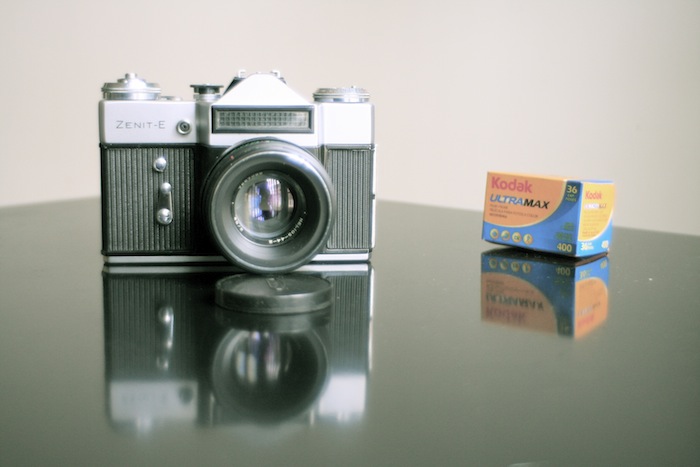zenit-e
Just like that, I was handed a Zenit-E by an elderly Slovakian gentleman. It had been well looked after, loved even - obviously, and it came complete with it's original everything. I was happy. I was very happy indeed.
The Zenit-E I believe was manufactured in western Moscow between the mid sixties to the early eighties. It's a rugged-as-heck pentaprism SLR camera capable of shutter speeds from B to 1/500. The default lens is the Helios-44-2 58mm f/2. It also has an inbuilt selenium cell exposure meter, which means no batteries are required what so ever. However the meter is not TTL, so it is somewhat equivalent to carrying a standalone meter.
I let this camera sit on the shelf for a few months before even loading it with its first roll for two reasons. One, I had a few other cameras ahead of this one to test. Two, I found the exposure meter a bit baffling at first, and after playing with it for a few hours and figuring it all out, decided to do away with it altogether. Anyhow, the highest ASA [ISO] setting is 500, so you'd have to mentally compensate for 800 speed film anyway right? So Sunny 16 it was henceforth.
The first roll I placed in the camera was a disaster. Loading the camera was straight forward. Unloading the film on the other hand, totally different ball game. Rewinding the film after you're done is like trying to dig through an iceberg with your bare hands. The rewind knob thing seems to me should have a lever of some kind [sort of like a spanner] that you can use to easily rewind the thing without taking a layer of skin off your fingers. The designers of the Zenit-E [oxymoronically speaking] clearly didn't think things through. As it was popular at the time, the Zenit-E was probably just an industrial copy of something else anyway.
It was hard to tell when the film had finished rewinding. Also, because I had fed too much film into the spool, it just stretched and snapped. Noobie error. Yes. Annoying, ugly, clunky old piece of metallic junk. Heavy, industrial probably radioactive [I thought to myself] door stop. So I put it away for a while longer.
And then one day I put in the second roll. 'Ah, who knows, its a cheap film anyway, whatever'. I loaded it correctly this time, put my Sunny 16 hat on - It was about an 8 to 11 outdoors. And suddenly, it was love at first snap. And here's why;
1. The Helios-44-2 58mm f/2 lens.
This lens is currently my favourite of all the lenses I own. The above photo was taken a f/2.8 in relatively low light. I loooooooove the way it allows you to focus at f/2 regardless of what aperture you are shooting at. Having said that, you need to be careful because like me you can end up shooting at f/2 in bright sunlight and overexposing to oblivion. Especially if you're shooting street and are trying to catch a moment.
The Helios also casts the most delicious colours unto any film. Great camera for shooting in London with it's sporadic bursts of colour. I remember feeling as if my eyes where selectively desaturating the world around me.
You can even see hints of that signature 'swirly bokeh' that rivals the astronomically priced Lomo Petzval of Kickstarter fame.
2. The camera weight.
Because the camera is so heavy, I don't worry much about blurring associated with pressing the shutter, even at 1/30 - which is what the above photo was taken at. So the Zenit-E, some 800 ISO film and the Helios f/2 lens make a perfect low light portrait combo [I used Lomography Lady Grey for here, which is 400 ISO].
3. The shutter.
This one is a little hard to explain. It's experiential and highly subjective. The way you 'feel' when you press the shutter of a camera is totally personal, and I will say this about the Zenit-E; I go 'ahhhh' inside when I press the shutter. It is something to do with the way the mirror reacts without shaking the camera [unlike the Praktica BX20 and BCA], and the subtle 'crunch' sound it makes. So very hard to explain, you'd have to use one to see what I mean.
So there. My beloved Zenit-E. Many things about this camera - such as the design - make no sense, but the camera is somehow more than the sum of its parts, and is a joy to use.











Comments
Post a Comment